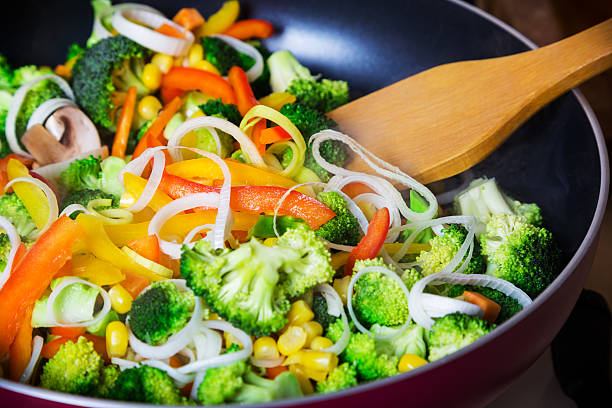
Sautéing vegetables is one of the best ways to highlight their natural flavors, offering a crispy texture on the outside while keeping them tender and flavorful inside. Whether you’re preparing a quick weeknight dinner or adding a side dish to a meal, sautéed vegetables are a go-to for their simplicity and versatility. In this guide, we’ll walk you through the perfect technique for sautéing vegetables, along with tips on selecting the right ingredients, seasoning, and heat control to get the best results every time.
Why Sauté Vegetables?
Sautéing is a fast cooking method that allows vegetables to maintain their color, texture, and nutrients while developing rich, caramelized flavors. When done properly, sautéing creates vegetables with crispy edges and a tender, juicy interior. Plus, it’s an easy way to prepare a variety of vegetables without overcomplicating the process.
The Technique for Perfectly Sautéed Vegetables
1. Prep the Vegetables
The first step to perfectly sautéed vegetables is proper preparation. Be sure to wash and dry the vegetables thoroughly before cooking. Excess moisture can cause the vegetables to steam instead of sauté, which prevents them from getting that crispy edge.
- Cut Evenly: For even cooking, try to cut your vegetables into uniform pieces. This helps ensure that all the pieces cook at the same rate. Aim for bite-sized pieces that are consistent in shape (slices, cubes, or strips, depending on the vegetable).
- Dry the Vegetables: If you’ve washed your veggies before cutting, make sure to pat them dry with a towel to remove any excess water. This helps them sauté, rather than steam.
2. Choose the Right Pan
A wide, heavy-bottomed pan works best for sautéing because it allows the vegetables to cook evenly. Non-stick or stainless steel pans are ideal, as they prevent sticking and promote even browning. A large pan also helps ensure that the vegetables have enough space to cook evenly without overcrowding.
If the pan is overcrowded, the vegetables will release too much moisture and steam instead of getting that perfect crispy edge. If you’re cooking a lot of vegetables, sauté them in batches for the best results.
3. Select the Right Oil
The choice of oil can greatly affect both the flavor and texture of your sautéed vegetables. Choose oils with a high smoke point for sautéing at medium to high heat, such as:
- Olive oil: Great for most vegetables, offering a mild flavor and healthy fats. Use extra virgin olive oil for the best flavor.
- Avocado oil: High in healthy fats and has a high smoke point, making it perfect for high-heat sautéing.
- Coconut oil: Adds a slightly sweet and aromatic flavor, ideal for vegetables with more robust flavors like sweet potatoes or carrots.
- Canola oil or grapeseed oil: Neutral oils with high smoke points, good for when you don’t want the oil flavor to overpower the vegetables.
Use enough oil to coat the bottom of the pan generously, but avoid using too much. You want the vegetables to cook evenly, not to swim in oil.
4. Control the Heat
Heat control is crucial when sautéing vegetables. Start with medium to medium-high heat and adjust as needed. The goal is to cook the vegetables quickly so they retain their texture, but you also want to achieve a nice, crispy exterior.
- Preheat the Pan: Heat the pan before adding the oil, ensuring it’s hot but not smoking. This will help to create that golden-brown crust on the vegetables.
- Medium-High Heat: Once the oil is added, heat it until it shimmers, then add the vegetables. If the heat is too low, the vegetables will release too much moisture and end up soggy. If it’s too high, they may burn before cooking through.
5. Sautéing Process
- Add the Vegetables: Once the oil is hot, add the vegetables to the pan in a single layer, leaving a little space between them. Don’t overcrowd the pan! If necessary, cook in batches.
- Stir Occasionally: Stir the vegetables every couple of minutes to ensure even cooking, but not constantly. Let them sit for a while between stirring to allow the edges to caramelize and become crispy. If you stir too often, they won’t have the chance to develop that perfect texture.
- Don’t Overcook: The vegetables should be tender but still have a slight bite. Avoid cooking them for too long, as they can lose their texture and flavor. Most vegetables will take about 5-10 minutes, depending on their size and type.
6. Finish and Season
Once the vegetables are perfectly sautéed, it’s time to season them. Fresh herbs like thyme, rosemary, or parsley can be added toward the end of cooking for a fresh burst of flavor. Also, don’t forget about the salt and pepper!
- Salt: Season the vegetables with salt early in the cooking process so the vegetables absorb it as they cook, but be cautious not to over-salt. Taste as you go.
- Pepper: Freshly ground black pepper adds a nice kick and enhances the flavors. Add it to taste.
- Optional Seasonings: You can also experiment with garlic, crushed red pepper flakes, lemon zest, or a dash of soy sauce or balsamic vinegar for added flavor.
Vegetables That Work Well for Sautéing
Not all vegetables are ideal for sautéing, but many common vegetables are perfect for this technique. Here are some of the best options:
1. Bell Peppers
- Sweet, tender, and flavorful when sautéed. Slice them into strips or cubes, and cook them until they’re just soft with crispy edges.
2. Zucchini
- Zucchini cooks quickly and becomes wonderfully tender. Slice into rounds or half-moons and sauté until golden brown. Be sure not to overcook, or it can get mushy.
3. Mushrooms
- Mushrooms sauté beautifully because they release moisture as they cook and then brown nicely. Slice them into thick pieces and cook until they have a crispy, caramelized exterior.
4. Onions
- Onions can be sautéed to enhance their sweetness. Slice thinly and cook slowly over medium heat until they become translucent and golden.
5. Asparagus
- Asparagus takes on a great flavor when sautéed, with tender stalks and a slightly crispy tip. Cut into 1-2 inch pieces and sauté until tender, with some brown spots.
6. Carrots
- Slice or julienne carrots to ensure they cook evenly. They add a lovely sweetness and crunch when sautéed, especially if you cook them until slightly caramelized.
7. Spinach and Leafy Greens
- Leafy greens, such as spinach or kale, can be sautéed quickly. Add them to the pan towards the end of cooking and cook just until wilted.
8. Broccoli
- Broccoli florets sauté well, especially if you steam them lightly beforehand to reduce cooking time. You’ll want to sauté them for a few minutes until they have a nice sear.
Tips for Perfect Sautéed Vegetables
- Batch Cooking: If you’re cooking a large quantity of vegetables, do it in batches to avoid overcrowding the pan.
- Don’t Skip the Drying Step: Excess moisture will cause your vegetables to steam instead of sauté. Be sure to dry them thoroughly before cooking.
- Use Fresh Ingredients: Fresh vegetables will provide the best flavor and texture, so try to use them as soon as possible after purchasing.
- Flavor Variations: Play around with different herbs, spices, and seasonings to customize the flavor of your sautéed vegetables. You can also finish them with a squeeze of lemon juice or a splash of balsamic vinegar for extra depth.
Mastering the art of sautéing vegetables is an essential skill that can elevate any meal. By following the right technique, selecting the right oil, and controlling the heat, you can create vegetables that are both tender and crispy with rich, caramelized flavors. Whether you’re sautéing bell peppers, zucchini, mushrooms, or leafy greens, the possibilities are endless for creating vibrant, tasty dishes that work as a side or a main course. Experiment with different combinations of vegetables and seasonings to discover your perfect sauté!
